Independence or Death (painting)
The 1888 painting Independence or Death (Independência ou Morte in Portuguese), also known as the Cry of Ipiranga (Grito do Ipiranga in the original), is the main artwork representing the proclamation of Brazilian independence.[1]
| Independence or Death | |
|---|---|
| Cry of Ipiranga | |
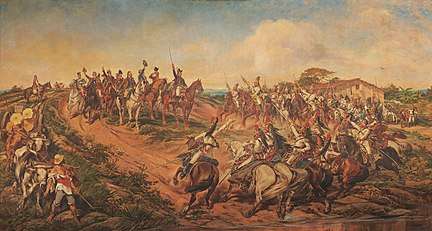 | |
| Artist | Pedro Américo |
| Year | 1888 |
| Medium | oil paint |
| Dimensions | 415 cm (163 in) × 760 cm (300 in) |
| Location | Museu do Ipiranga, São Paulo, Brazil |
Author
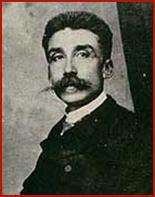
Pedro Américo was born in 1843, in the Paraíba Province of Brazil, more specifically in the now city of Areia, at the time the small town of Brejo d'Areia. Since his youth, he showed a vocation for painting, being ten years old when he participated as a drawer of flora and fauna in an scientific expedition through Northeastern Brazil lead by the French naturalist Louis Jacques Brunet. At approximately 13 years old, he entered the Imperial Academy of Fine Arts, in the city of Rio de Janeiro. His performance at the Academy made him known even to the emperor D. Pedro II, who sponsored a trip to Paris and studies at the École nationale supérieure des Beaux-Arts, where the artist perfected his style, mainly in historical painting. His most famous work, Independence or Death (Portuguese: Independência ou Morte), was shown for the first time in the Accademia di Belle Arti di Firenze ("academy of fine arts of Florence") in 1888-04-08. After going to Brazil, remaining there for a few years, he returned to Florence, where he died in 1905.[2][3]
Context
Pre-execution agreements
Contrarily to what is speculated, Pedro Américo was not invited to execute the painting dedicated to independence: the artist himself offered to do it. In 1885, according to records made by imperial adviser Joaquim Inácio Ramalho, Américo declared to the commission of works, that he would charge himself with making a historical painting in memory of the glorious act of Prince Regent Pedro I, proclaiming Brazilian independence[4]. Américo's proposal was not immediately accepted, due to a lack of funds and the architecture of the building that would in the future become the Museu Paulista. In December of the same year, the newspaper A Província de São Paulo published an article criticising the government's behaviour, accusing it of giving false hopes to the artist, considered at the time a master of aesthetics. [4]
It's believed that those provocations made by the media contributed to a change in the position of the commission responsible for accepting or refusing Américo's proposal. By the end of December 1885, Ramalho writes a letter to Pedro Américo accepting his proposal. [4]
In a contract signed in 1886-07-14 between Pedro Américo e Ramalho,[2] at the time president of the Commission of the Monument to the Independence of Brazil, the artist committed himself to painting, accordingly to the description of the documents, a "commemorative historical painting of the proclamation of independence by the prince regent D. Pedro in the fields of Ypiranga" (Portuguese: "quadro histórico comemorativo da proclamação da independência pelo príncipe regente D. Pedro nos campos do Ypiranga". The deadline for the painting of the work would be three years, and Américo would be paid thirty contos de réis, in addition to the six contos that the artist received when he signed the contract, money destined to the first studies and preparatory activities for the work[4]. Entirely painted in Florence, it was finished a year before due, in 1888. [2]
History
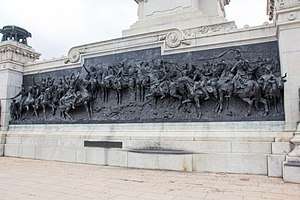
The artist Pedro Américo finished the painting in 1888 in Florence, Italy, 66 years after the proclamation of independence. The Brazilian imperial house commissioned the work, due to investments into the construction of the Museu do Ipiranga (presently the Museu Paulista[5]). The goal of the artwork was to emphasize the monarchy.[1]
Controversy
There exists evidence that the painting is not an accurate description of the events on the shores of the Ipiranga Brook.[1]
Plagiarism accusation
Pedro Américo as a copier
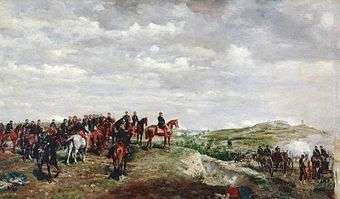
The painting by Pedro Américo can be compared with other works made by different artists. That resulted in plagiarism accusations to the painter. In his work, Américo creates a dialogue between art history and the traditional battle paintings that emphasised the hero (previously made by his teachers). The process of making the painting was complex.[6] The dialogue with historical paintings was well regarded by the Imperial Academy of Fine Arts, in addition to being a technique used by many artists, without being considered a copy. He intended to develop an image that reminded of those works from the past accordingly to the techniques that were used by those artists.[7]
The experience he had 10 years earlier, with his work Batalha do Avaí, that was not well received by critics, classifying it as "anti-academical" (Portuguese: antiacadêmica), made him study in more depth aesthetic topics and publish the literary work Discurso Sobre o Plágio na Literatura e na Arte (Discourse On Plagiarism in Literature and Art) in 1879, years before beginning Independência ou Morte.[8]
The works by French painters Jean-Louis Ernest Meissonier and Horace Vernet were used as sources for Independência ou Morte. Américo studied the works Napoleon III at the Battle of Solferino (1863) and 1807, Friedland (c. 1870), both by Meissonier and also Bataille de Friedland, 14 juin 1807 (c. 1850), by Vernet. There are similarities between the paintings: the confrontation between D. Pedro and the soldiers to the right has composition similar to the structure of 1807, Friedland: the concentration of people in both paintings is similar; [4] the elevation of D. Pedro to a higher point in the topography approaches the work of Américo to those of Meissonier. In addition, it can be deduced that Américo wished to portray D. Pedro as a statesman, as can be noticed when analysing the figure of Napoleon in the work of Meissonier.[6]
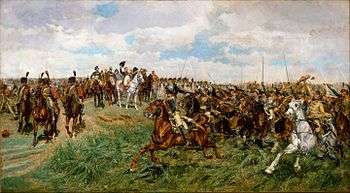
The historian Lilia Moritz Schwarcz quotes in his book Batalha do Avaí – A Beleza da Barbárie (Battle of Avaí - The Beauty of Barbarism), that the critics of the work by Pedro Américo saw in both A Batalha do Avaí, as in Independência ou Morte, two "brazen" (Portuguese: "descarados") cases of plagiarism of the painters Andrea Appiani and Ernest Meissonier, respectively. According to the historian, the critics saw in Independência ou Morte, a whole scene copy of 1807, Friedland, painted thirteen years earlier by Meissonier, "in which he also portrays Napoleon, a polyvalent figure that serves as a model for Américo to paint both Caxias and D. Pedro I, this one giving the cry of independence at the bank of the Ipiranga" (Portuguese: "em que este também retrata Napoleão, figura polivalente que tanto serve de modelo para Américo pintar Caxias como D. Pedro I, este dando o grito de independência às margens do Ipiranga.").[9]
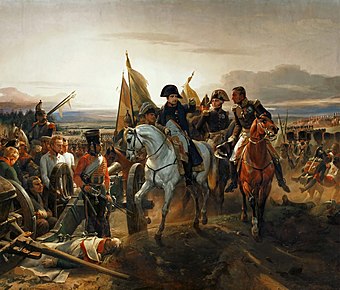
According to the art historian Maraliz de Castro, the work by Américo has major differences from the paintings by Meissonier, saying the Brazilian concerns himself with every detail, searching for a balance between all the elements, with the goal of creating a significant impression of unity, while in Napoleon III at the Battle of Solferino, the Frenchman wished to simulate a instantaneous photography of reality differently from the carefully organised figures in Independência ou Morte. According to Maraliz, another difference is the movement in the painting by Meissonier: the soldiers run frenetically in direction to the viewer; however Américo composes a form in elipsis to make up all the characters of the scene, uniting them to the use of perspective. [10] In the other hand, according to the art historian Cláudia Valladão, these details reaffirm the traditional values of Américo, as however he agreed with the group of theoreticians at the time called "idealists", his artistic position was directed at a dialogue with the "realist" tendencies of historical painting, as used by a variety of artists at the time, for example Meissonier.[11] There was also an contemporary accusation of plagiarism published in 1982 by the journalist Elio Gaspari, in his column in the magazine Veja, also refuted by Cláudia Valladão, that comments on the publication: "accusing Pedro Américo of plagiarism is not understand the assumptions of his art" (Portuguese: "acusá-lo [Pedro Américo] de plágio é não compreender os pressupostos de sua arte").[12]
Inspiration pictures
Pedro Américo used some historical paintings as references to compose the artwork Independência ou Morte.[7]

Comparing Américo's painting with A Proclamação da Independência by François-René Moreaux, one realizes that the latter includes many more civilians than the Brazilian in his artwork. The characters in Moreaux's painting look at the sky. Consequently, the emperor is portrayed as a figure fulfilling a divine will by proclaiming independence, not as someone with leadership and political abilities, as done by Américo.[6]

In contrast, the works Independência ou Morte and Retrato de Deodoro da Fonseca from the painter Henrique Bernardelli (which represents the officer declaring the end of the monarchy and the beginning of the republic in Brazil) complete one another: both complied to the interests of the 1889 republic and reaffirmed that historical changes in Brazil were marked by heroes and grandiose events. They illustrate independence and are effective in its propaganda, even if they don't question the new Brazilian autonomy with veracity.[13]
Furthermore, Bernardelli's painting portrays the event in an epic and idealized manner, as in Pedro Américo's artwork. Deodoro, in reality, was sick and constantly bed-ridden, with a chronic lack of air caused by Arteriosclerosis. Accordingly to reports by the lawyer Francisco Glicério, who participated in the Proclamation of the Republic, the marshal barely had enough strength to put on his uniform. Unlike what is shown in the painting, he was weak and staggering, not being able to stay on top of his horse.[14]
Legacy


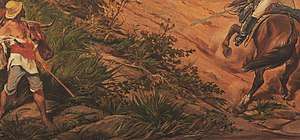
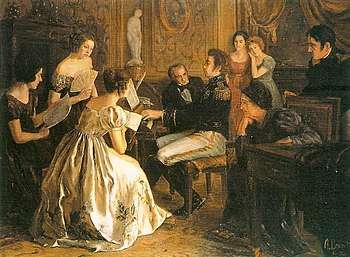
Diffusion in didactic books, monuments and digital media
The painting by Pedro Américo appears constantly in Brazilian didactic books, therefore becoming a "canonical image" (Portuguese: "imagem canônica") in the teaching of history in Brazil. [15] A study with children has shown that in part due to the influence of the illustrations in didactic books, they represented the act of independence inspired by the graphical reference of Independência ou Morte.[16] In the books, the painting is used to illustrate the act of founding the Brazilian nationality, showing that the transition to independence is the result of a cry. [17] That common interpretation, represents the cry of Ipiranga as a direction, in a personalised act and centralised in the monarch.[18]
The importance of the work by Pedro Américo, the official portrayal of independence, resulted in it influencing other works, among which the pediment of the Monument to the Independence of Brazil, which emulates the work of Américo.[19]
The painting by Pedro Américo is part of the collection available in the project Google Arts & Culture.[20] The work was digitalised as a gigapixel image with Google's Art Camera, to record details in the work that are imperceptible to the naked eye. Independência ou Morte is the largest painting to be digitalised by Google in Brazil. [21][22]
Influence on painting
The work by Pedro Américo became the reference, sometimes to be deconstructed, of the portrayal of Brazilian Independence. Creating an alternate version to that of the heroism and triumphalism of Dom Pedro, portrayed by Américo, set the tone, for example, for the production of highlighted works in expositions celebrating the Independence Centenary, as Sessão do Conselho de Estado (Session of the State Council) , by Georgina de Albuquerque, and Primeiros Sons do Hino Nacional (First hearing of Independence Anthem), by Augusto Bracet. In the painting by Albuquerque, the protagonist of the declaration of independence becomes Maria Leopoldina, in a scene where she is shown deliberating with the Council of the Attorneys-general of the Provinces of Brazil the direction to Dom Pedro to end the colonisation of Brazil by Portugal; in the painting by Bracet, Dom Pedro appears as the protagonist of the separation from Portugal, but in a domestic setting and in a jovial attitude, composing the Hino da Independência (Independence Anthem). [23]
Notes
- "O grito do Ipiranga aconteceu como no quadro?". uol.com.br. Archived from the original on October 4, 2012. Retrieved November 2, 2012.
- "Pedro Américo". UOL Educação. Archived from the original on April 27, 2018. Retrieved April 28, 2018.
- "Pedro Américo". Britannica Escola. Archived from the original on April 27, 2018. Retrieved April 28, 2018.
- Oliveira & Mattos 1999.
- "Quadro de Pedro Américo de Figueiredo "Independência ou Morte"". Archived from the original on November 13, 2013. Retrieved November 13, 2013.
- Schlichta 2009.
- Franco 2008.
- Oliveira & Mattos 1999, p. 115.
- Filho, Antonio G. (December 13, 2013). "Lilia Schwarcz investiga o lado republicano da tela de Pedro Américo". O Estado de S. Paulo. Archived from the original on January 18, 2017. Retrieved May 20, 2018.
- Christo 2009.
- Oliveira & Mattos 1999, p. 126.
- Oliveira & Mattos 1999, p. 97.
- Souza 2000.
- Bueno 2013.
- Purificação 2002, pp. 31-40.
- Neto 2017, p. 114.
- Neto 2017, p. 115.
- Andrade 2016, p. 147.
- Braziliense, Correio; Braziliense, Correio (September 11, 2018). "Acervo do Museu Paulista da USP passa a colaborar com o projeto Google Arts". Correio Braziliense (in Portuguese). Retrieved December 29, 2018.
- "Museu Paulista da USP está digitalizado na plataforma da Google - Arte". Canaltech (in Portuguese). September 10, 2018. Retrieved December 29, 2018.
- "Retorno online do Museu do Ipiranga www.jb.com.br - País". www.jb.com.br. Retrieved December 29, 2018.
- Cavalcanti Simioni 2014.
References
Books and theses
- Oliveira, Cecilia Helena de Salles; Mattos, Claudia Valladão de (1999). O Brado do Ipiranga. São Paulo: Edusp. ISBN 978-85-314-0518-1.CS1 maint: ref=harv (link)
- Souza, Iara Lis Carvalho (2000). A Independência do Brasil. Rio de Janeiro: Jorge Zahar. ISBN 9788537807545.
- Lima, Oliveira (1997). O Movimento da Independência, 1821-1822. Rio de Janeiro: Topbooks.
- Américo, Pedro (1888). Alguns discursos do Dr. Pedro Americo de Figueiredo (PDF). Florença: Imprensa de l'Arte della Stampa. (Work in the public domain)
- Schlichta, Consuelo Alcioni Borba Duarte (2006). A pintura histórica e a elaboração de uma certidão visual para a nação no século XIX (tese doutorado). Curitiba: Universidade Federal do Paraná. Archived from the original on July 8, 2018. Retrieved May 25, 2018.
- Franco, Pablo Endrigo (2008). O riacho do Ipiranga e a independência nos traços dos geógrafos, nos pincéis dos artistas e nos registros dos historiadores (1822-1889) (Mestrado). Universidade de Brasília.CS1 maint: ref=harv (link)
- Purificação, Ana Teresa de Souza e Castro da (December 18, 2002). (Re)criando interpretações sobre a Independência do Brasil: um estudo das mediaçoes entre memória e história nos livros didáticos (Mestrado). Universidade de São Paulo. doi:10.11606/D.8.2002.tde-18092003-193651.CS1 maint: ref=harv (link)
- Andrade, Fabricio Reiner de (March 5, 2016). Ettore Ximenes: monumentos e encomendas (1855-1926) (Mestrado). Universidade de São Paulo. Retrieved May 22, 2018.CS1 maint: ref=harv (link)
- Castro, Isis Pimentel de (2007). Os pintores de história: a relação entre arte e história através das telas de batalhas de Pedro Américo e Victor Meirelles (Mestrado). Universidade Federal do Rio de Janeiro. Retrieved May 22, 2018.
Journals
- Schlichta, Consuelo Alcioni B. D. (2009). "Independência ou Morte (1888), de Pedro Américo: A pintura histórica e a elaboração de uma certidão visual para a nação". ANPUH – XXV Simpósio Nacional de História.CS1 maint: ref=harv (link)
- Schwarcz, Lilia Moritz (2009). "Paisagem e Identidade: A construção de um modelo de nacionalidade herdado do período joanino". Revista Acervo. 22 (1). ISSN 2237-8723. Retrieved May 22, 2018.
- Mattos, Claudia Valladão de (1999). "Da Palavra à Imagem: sobre o programa decorativo de Affonso Taunay para o Museu Paulista". Anais do Museu Paulista. 6 (1). Retrieved May 22, 2018.
- Christo, Maraliz de Castro Vieira (2009). "A pintura de história no Brasil do Século XIX: Panorama introdutório". Arbor. 187 (740). Retrieved May 22, 2018.CS1 maint: ref=harv (link)
- Bueno, João Batista Gonçalves (August 8, 2013). "Tecendo reflexões sobre as imagens pictóricas (do final do século XIX e início do século XX) utilizadas nos livros didáticos no Brasil". Fóruns Contemporâneos de Ensino de História No Brasil On-line. 1 (1).CS1 maint: ref=harv (link)
- Neto, José Batista (July 7, 2017). "A Problemática do Ensino da História nos Textos e nas Imagens dos Livros Didáticos". Tópicos Educacionais. 13 (1–2). ISSN 2448-0215.CS1 maint: ref=harv (link)
- Cavalcanti Simioni, Ana Paula (April 2, 2014). "Les portraits de l'Impératrice. Genre et politique dans la peinture d'histoire du Brésil". Nuevo Mundo Mundos Nuevos (in French). doi:10.4000/nuevomundo.66390. ISSN 1626-0252.CS1 maint: ref=harv (link)
- Oliveira, Emerson Dionisío Gomes de (July 2008). "Fragmentos de cumplicidade: arte, museus e política institucional". Métis: História e Cultura. Universidade de Caxias do Sul. 7 (13). ISSN 2236-2762. Retrieved May 22, 2018.
- Almeida, Rodrigo Estramanho de (2017). História e política do Brasil na pintura de Pedro Américo. 9.º Congresso Latino-Americano de Ciência Política. Retrieved May 22, 2018.
- Giordani, Laura (2016). O grito do Ipiranga: a independência do Brasil das galerias aos quadrinhos (PDF). XIII Encontro Estadual de História da ANPUH RS: Ensino, direitos e democracia. Retrieved May 22, 2018.
External links

- "O Brado do Ipiranga: a cena que Pedro Américo imaginou para o Brasil". Canal Ciência USP no YouTube (in Portuguese). Retrieved May 24, 2018.
- "The Independence of Brazil on canvas: Creating an Image". Google Arts & Culture. Retrieved December 29, 2018.